The 19th “Tabete-Mite-Zadankai (Chefs chat)”
The 19th “Tabete-Mite-Zadankai (Chefs chat)”
On Monday, September 1, 2025, the 19th Tabe-te Mite Zadankai was held.
Since its first event in October 2020, the roundtable has been organised by Washoku Lovers through its 18th session. From this 19th session onward, the newly established nonprofit organisation Washoku Oceania Network (WON) has taken over as host.
With the cooperation of Hideo Dekura, Japanese Cuisine Goodwill Ambassador to Australia, this was the very first roundtable hosted under the new NPO. The weather was fine on the day, and many participants gathered even before the 3:00 p.m. start, setting a warm and friendly atmosphere.
The moderator was Yuri Tazunoki, former representative of Washoku Lovers and now Vice Representative of WON, who has served as MC since the very first session. She smoothly guided the program while also introducing the newly established NPO.
Participants included chefs and professionals active on the front lines of the food and beverage industry. After introductions, greetings were given by Mr. Hideo Dekura, WON board members Takashi Ohuchi, Ryota Kumasaka, Yuri Tazunoki, and Takumi Kawano, the current representative of WON and lecturer for this session—marking the official start of the Chefs chat.
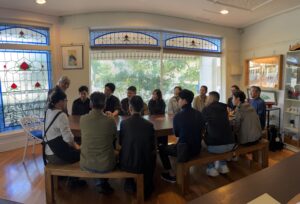
Lecture by Takumi Kawano
This was Mr. Kawano’s third appearance as a lecturer, following the 1st and 14th sessions. His past presentations were:
-
1st Session (2020): Demonstration and philosophy of cuisine, featuring Tai Chazuke, based on his experience at the renowned restaurant Kicho.
-
14th Session (2024): A lecture on the history of Japanese cuisine and health-conscious meals, with modern adaptations of Ichiju Sansai and Shojin Ryori.
For this 19th session—the first under the new NPO—the themes were:
-
“Experiencing the World of Wa through Visual Presentation and Flavor Transformation”
-
“Savoring the Seasonality of Japan through Art and Taste”
A truly unique and experimental program.
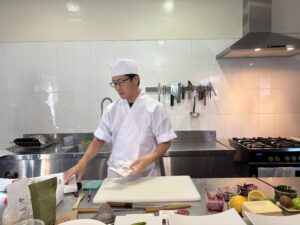
Part 1: Painting Seasonal Landscapes with Ingredients
The first session showcased the challenge: “How far can we express the Japanese world using only plain white plates, without traditional Japanese tableware?”
Since authentic Japanese ceramics such as Oribe or Bizen ware, or traditional motifs like karakusa, sansui, or Tatsutagawa patterns are difficult and costly to obtain overseas, alternative approaches were demonstrated.
Natural ingredients such as matcha, beetroot, and blackberries were treated like “paints” to depict landscapes of cherry blossoms or bamboo on plates. The resulting dishes resembled paintings, and participants joined in to experience the depth of food-based artistic expression.
The matcha used was provided by Simply Native, and its vivid color, aroma, and fine texture drew admiration from attendees.
A special technique was also presented: creating designs that look like brushstrokes on white porcelain. The key lay in controlling concentration, an idea inspired by molecular gastronomy. Using a natural, specially prepared powder (neither starch, xanthan gum, alginates, nor calcium), Mr. Kawano demonstrated calligraphy-like strokes, an exclusive reveal for this event, leaving a strong impression.
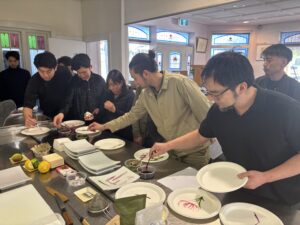
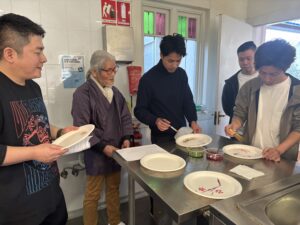
Part 2: Miracle Fruit Experiment – Changing Taste Perception
In the second half, participants engaged in a tasting experiment using the rare Miracle Fruit (Miracle Berry), sourced through Mr. Kawano’s unique network.
This small red fruit contains a glycoprotein called miraculin, which binds to sweet receptors on the tongue, transforming sour flavors into sweetness. Foods like lemon, lime, and grapefruit suddenly tasted remarkably sweet—like a magic trick.
A variety of items were prepared: lemons, limes, green apples, kiwis, grapefruits, cherry tomatoes, and kumquats. In addition, dishes such as beet-colored sauerkraut and an original berry dessert were served.
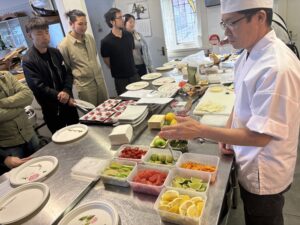
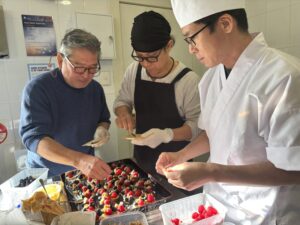
The dessert consisted of gluten-free rice crackers topped with blueberries, raspberries, and blackberries, accented with Japanese seasonings (miso and kinako), the Australian native herb lemon myrtle, and a hidden touch of mascarpone cheese. Malic and citric acids were included to maximize the taste transformation experience.
Using diagrams, Mr. Kawano also explained the molecular mechanism: how miraculin binds to sweet receptors, altering the perception of sourness into sweetness. This allowed participants to appreciate the usually overlooked depth of acidity, sparking lively interest.
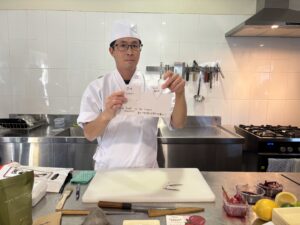
Handouts summarized additional insights, including:
-
Other factors that influence taste perception
-
How taste changes during flights and its relation to Japanese cuisine
-
Four additional natural foods that can alter taste perception
This combination of lecture, demonstration, and tasting provided an opportunity to reconsider how both taste and visual presentation can be harnessed in culinary creation.
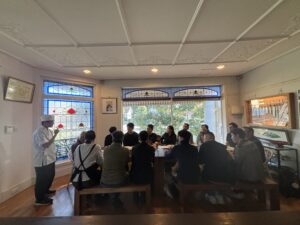
Conclusion
The 19th Roundtable (the 1st under WON) concluded with great success.
Participants commented that it was “a fresh and eye-opening experience” and that they “felt the potential of cuisine”.
If reading this makes you want to experience it yourself, please leave us a comment—if there’s enough demand, we will consider holding it again.
Looking ahead, WON will continue to collaborate with chefs and cultural professionals to explore and share the richness of Japanese cuisine.
Events are announced first to registered members (free of charge), who also enjoy invitations and discounts. We encourage you to join!
Chefs who feel “I’d like to share my dish with the world” or “I’d like to take the stage as a lecturer” are warmly invited to get involved.